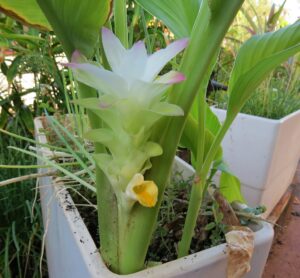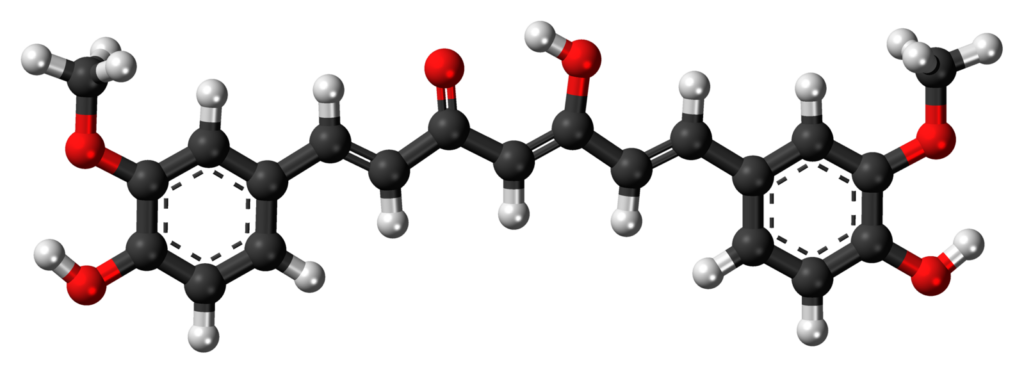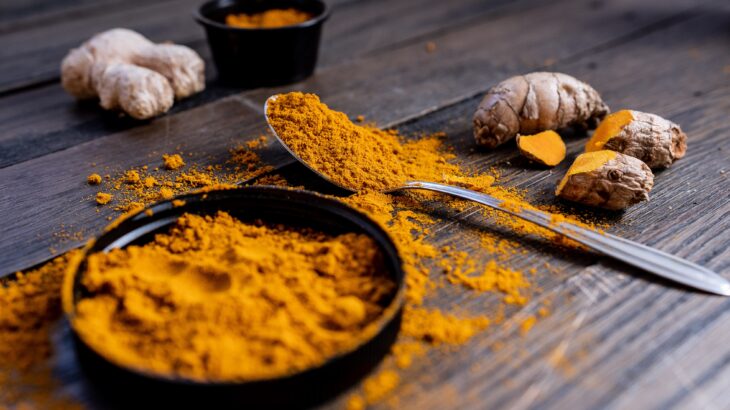By Zahra Nasser, Chemistry Editor
To many, turmeric may only be an ingredient used in curry, but there is a lot more to the traditional Indian spice than meets the eye. Historically, turmeric has been used in Ayurveda, a type of naturopathic medicine introduced in India over 3000 years ago that promotes natural therapies to re-establish balance in the body, mind and spirit as a means of curing or preventing disease. Though Ayurveda is fundamentally different from the conventional medicine widely practiced in Canada, interest in the use of turmeric in Western medicine has been growing since evidence-based research began reporting the beneficial effects of curcumin, the active ingredient in turmeric.

Curcuma longa, a flowering plant belonging to the ginger family. Turmeric is extracted from its rhizomes. Image: David Eickhoff, CC BY-NC-SA 2.0.
Turmeric is derived from the rhizomes, or rootstalk, of Curcuma longa, a flowering ginger plant native to India. It is not uncommon for plant products to be effective against disease and infections. Plants produce many substances as natural defense mechanisms, and in some cases their pharmacological properties are also functional and effective in humans. Anecdotal evidence has long pointed to the potential health benefits of turmeric, but a lack of empirical evidence regarding turmeric’s mechanism of action in the body has prevented it from being employed in mainstream medicine.
Turmeric is composed of more than 100 chemical ingredients, the most prominent and well-known being curcuminoids, the compounds that give turmeric its bright yellow/orange colour. Curcumin, the main curcuminoid in turmeric, is the compound that has been investigated the most for its potential anti-inflammatory and antioxidant characteristics.
Inflammation is a natural immune response important for healing and limiting the spread of infection. Acute inflammation is rapid and transient, while chronic inflammation is a prolonged and harmful over-inflammatory response and a common disease pathology. A study conducted in 1997 using mice showed that curcumin can bind to and suppress the activity of certain enzymes, such as cyclooxygenase-2 (COX-2) and lipoxygenase (LOX), that mediate inflammatory responses. As a result, mice treated with curcumin showed a reduced inflammatory response compared to those not treated. Interestingly, COX-2 is also associated with uncontrolled cell division, a characteristic of malignant tumour development. In fact, there is evidence that curcumin inhibits carcinogenesis for a variety of cancers including those of the colon, breast and prostate.
Researchers have also found a key advantage of curcumin is that it is not toxic even when consumed at high doses, likely due to the low bioavailability of curcumin in humans and animals. When consumed, curcumin is rapidly metabolized and has poor absorption efficiency, making it unlikely to reach the bloodstream in large amounts. However, this also makes curcumin’s impact on the body difficult to study in a robust manner.
Nonetheless, research in 2012 from the University Health Network in Toronto showed that curcumin, when fed to mice on a high-fat diet, reduced inflammation, insulin resistance and fat accumulation. Results like these present possible new therapeutic uses for curcumin to treat type 2 diabetes and decrease insulin resistance.
More recent findings have begun to reveal the molecular mechanism by which curcumin impacts the immune system by reducing the expression of particular receptors on macrophages – immune cells that kill pathogens and trigger the activation of other immune cells. This modulation is important for relieving the discomfort of pain and inflammation, and also aids in controlling for over-reactive immune responses. Amid the COVID-19 pandemic, research into the possible use of curcumin to lessen the severity of the virus’s symptoms revealed that curcumin supplementation led to a decrease in common symptoms, duration of hospitalization, and deaths.

The molecular structure of curcumin. Evidence has shown that it can bind to and suppress particular enzymes involved in inflammation and cell proliferation. Image: Wikimedia Commons, CC0 1.0.
It seems as though curcumin is the golden cure and can be used to treat and possibly prevent some of the most notorious diseases faced by humans. So, why hasn’t curcumin overtaken the medical field as a therapeutic for maladies like inflammatory diseases and cancer? First, curcumin is not foolproof – as with any treatment, there are some associated drawbacks. Its effects take time to impact the body and negative side effects have been reported, with prolonged consumption at high doses being linked with nausea, diarrhea and yellow stool.
But the larger problem is that, despite the scientific research devoted to discovering more about curcumin, there is simply not enough data for medical professionals to feel confident about its efficacy for treating specific conditions and diseases. Research regarding how curcumin interacts with other medications and chemotherapeutic drugs is scarce. Dosing, duration of use, and long-term side effects are not well known and there have been no studies conducted in children. In traditional use, low-level consumption of turmeric over a long period of time was thought to be most beneficial, but those guidelines are insufficient for clinical use. The initial introduction of curcumin as a clinical treatment would likely be low-profile, such as an alternative non-steroidal anti-inflammatory drug (NSAID) to treat pain and inflammation, but without the severe gastrointestinal issues associated with NSAIDs, like peptic ulcers and bleeding.
Unfortunately, there are also issues when it comes to recommending natural products as medication and health remedies. The U.S. Food and Drug Administration (FDA) has not approved curcumin for the treatment of any medical conditions, and it is currently labelled as a dietary supplement. This means curcumin supplements are regulated as a food product, not a drug. For products such as curcumin that have increasing evidence suggesting drug-like effects, it is important to have tight regulations concerning distribution standards. Dietary supplements are not formally reviewed for manufacturing consistency, so ingredients and recommended dosages may vary considerably between companies. Health Canada labels curcumin as a natural health product that is a source of antioxidants and provides relief from joint inflammation, though dosing guidelines remain elusive.
With the growing evidence of curcumin’s medical benefits and greater availability of supplements, people may become overly optimistic about the positive effects of curcumin, which can lead to excessive consumption of a product that has significant biological impacts. Being a natural product, it’s best to use and consume curcumin in moderation, and understand that supplementation for specific medical effects is not currently supported by data nor strictly regulated.
Feature image: Turmeric, known as the “golden spice” has long been used in both Indian cuisine and Indian holistic medicine. Image: Karl Solano, CC.




